What are the sockets, their device, types and classification
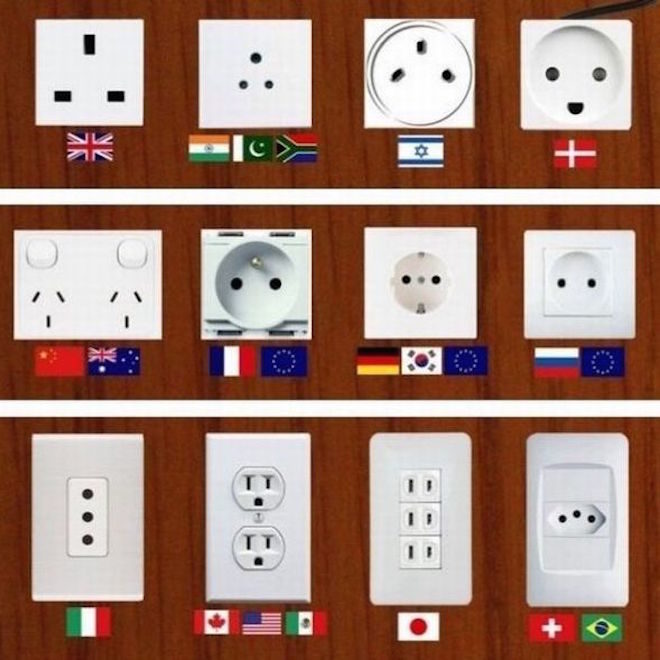
Despite the existence of uniform global standards, they are not always widely used in different countries, which must be taken into account, for example, when traveling on a business trip. The same types of sockets familiar to the eye, common in the CIS countries and parts of European countries, cannot be used to charge the phone or connect a laptop brought from the USA or Japan. In addition, even if you choose an outlet on the domestic market, then devices with their own connectors and functionality are provided for different tasks.
Content
Common details and design differences in different countries
The laws of electrical engineering work the same everywhere - on earth, under water or on the moon, so the fundamental structure is always and everywhere the same, regardless of what kind of socket is used for the type and purpose. Its main task is to provide a simple connection and disconnection of an electrical appliance to a stationary power grid. As a result, the elements and materials will be the same everywhere, and the main difference will be in their form, which is historically used in different countries.

The main types of sockets used in different countries:
- A - USA and Japan - 110 volt outlets.
- B - The same type A, only with a ground contact.
- C - For operation in 220 Volt and 50 Hertz networks. Distributed in the CIS countries and a number of European countries.
- D - British female connectors. Almost the same are used in South Africa.
- E - French version of type C socket, but with a grounding contact.
- F - German version of type C for wiring with ground
- G - Another standard from Britain.
- H - Standard in Israel.
- I - Devices installed in Australia.
- J - Swiss socket.
- K - Danish version of type C socket for grounding.
- L - Italian simplicity and functionality.
This video tells in detail about the features of electrical networks and, in particular, outlets in different countries of the world:
What parts are sockets assembled from?
From the above devices, it can be seen that all types of household sockets, despite their different designs, have a common structure. The design of a standard outlet includes two main connectors for phase and zero, and if the model takes into account the presence of grounding, then there will be three contacts. Accordingly, if the voltage and current frequency supplied to it come up to the device that needs to be turned on, then if there is an adapter, it will work.
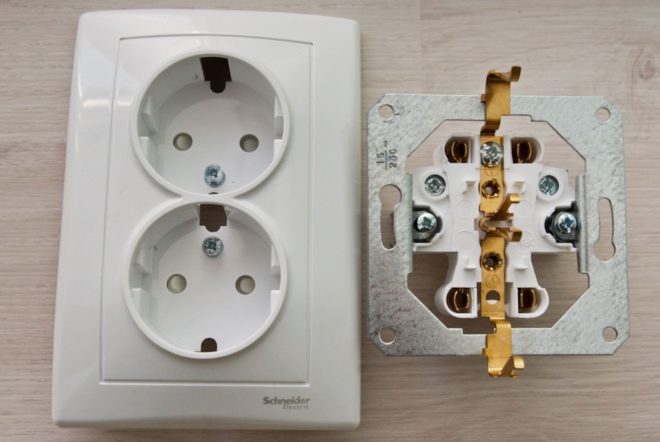
The socket device, regardless of its type, type and characteristics, includes the following elements:
- The base is made of dielectric - ceramic or plastic. The ceramic base can withstand high temperatures in case of overheating of the contacts, but is more fragile. At the base there are sockets for contacts, a fastening mechanism and holes in the thread for screwing the cover.
- Fastening mechanism. For internal sockets, these are spacer lugs, and in the external one there are simply holes in the base for screws.
- The main contacts are for phase and zero. That part of them that grasps the contacts of the plug can be additionally spring-loaded to make the contact more tight. Additionally, they have a wire holder.
- The grounding pin is optional, but most devices have one.
- Plastic cover - covers the current-carrying elements and protects them from dust and water. It can consist of two parts - decorative and fastening.
These are common parts that are found in any outlet, but there are also devices on the market with additional features in which this list will be wider.
Differences by installation type

According to this criterion, the types of electrical outlets are divided into two main categories: indoor and outdoor.
The first type of devices is used most often, despite certain difficulties associated with their installation - installation takes place into the wall, for which you need to cut a hole in it for the outlet itself and a groove for the wire that will fit it. These disadvantages are covered by undoubted advantages in terms of aesthetics and fire safety - you do not have to stumble over the wires, risking ruining them, and if a short circuit suddenly occurs, then it is not scary in the thickness of the wall.
External types of sockets are most often used when it is necessary to lay temporary wiring or in wooden houses, where the installation of internal wiring is regulated by very strict restrictions and is practically not used. Also, the external method is often attached to power outlets, which have large dimensions.
Specifications - Power & Household Outlets
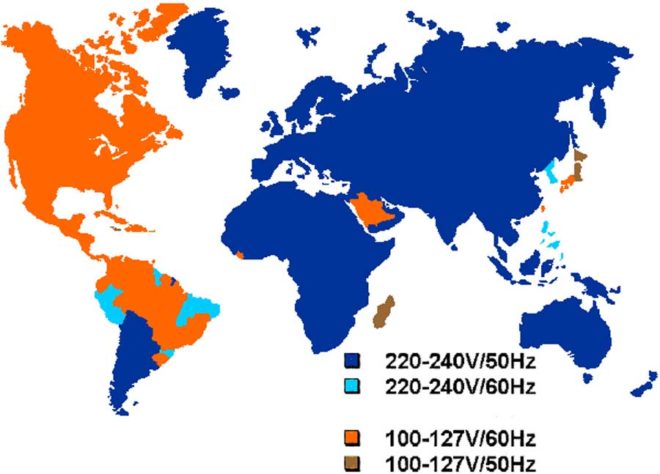
Worldwide, only two standard AC frequencies are used - 50 and 60 Hertz. These values are absolutely not important for the outlets themselves - only the amount of current losses during its transportation over long distances depends on them.
There are also few voltage standards - 100, 110, 115, 120, 127, 220, 230 and 240 volts. Given that the permissible deviations are +/- 10%, we can assume that there are two main standards - 127 and 220 volts.
Much more attention should be paid to what kind of sockets are in terms of the current strength for which their contacts are designed - in modern household devices these are 10 and 16 Amperes. If you need to connect a device designed for high amperage, then you need to install a power outlet under it - usually they are designed for 32 Amperes. The fundamental difference between them is in the thickness of the contacts, due to which a large area of their contact is obtained.
Varieties by purpose
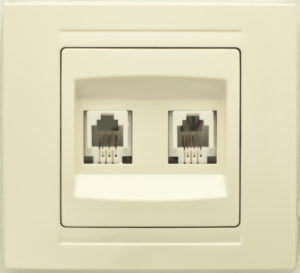 If initially sockets were used exclusively for powering electrical appliances from the mains, then with an increase in the number of wires in an average house, it became necessary to hide some of them in cable channels and draw conclusions. As a result, new types of outlets have appeared, which have become the leads of antenna wires for TVs, cables for Internet connection of computers, radios and stationary telephones. Recently, even socket terminals have been installed to which you can connect speakers from an audio system and a USB cable to charge your phone.
If initially sockets were used exclusively for powering electrical appliances from the mains, then with an increase in the number of wires in an average house, it became necessary to hide some of them in cable channels and draw conclusions. As a result, new types of outlets have appeared, which have become the leads of antenna wires for TVs, cables for Internet connection of computers, radios and stationary telephones. Recently, even socket terminals have been installed to which you can connect speakers from an audio system and a USB cable to charge your phone.
Regardless of what the socket is used for, its main components remain the same - the base, the fastening mechanism, the contacts and the insulating (also decorative) cover.
Additional functions
When pressing issues are resolved, they begin to engage in comfort - the following types of outlets are premium devices with additional functionality that allows them to improve their operating conditions.
- Protective curtains. First of all, they are intended to prevent children's pranks with pushing nails and other objects into the sockets. Additionally, they prevent dust and debris from entering.
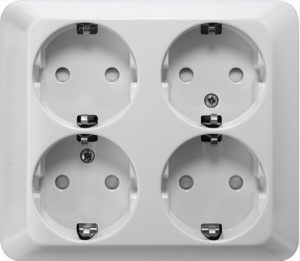
- Moisture protection. The housing is designed in such a way that liquid cannot seep inside the device. Depending on the protection class, such devices can withstand direct splashes or even submersion under water to a depth of about one meter.
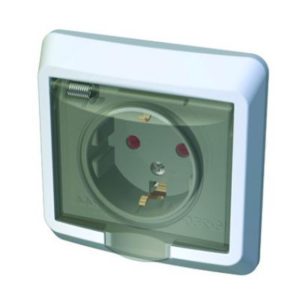
- Fork ejector. If you often insert and remove the plug into the outlet, this always slightly displaces its mechanism inside the wall, which eventually leads to its falling out. The ejector button is pressed towards the wall, which allows you to forget about this problem.
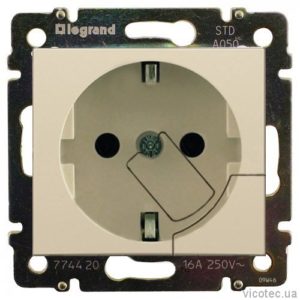
- Backlight. For those who often charge their phones or turn on other devices in the evening or at night, but do not want to turn on the main lighting.
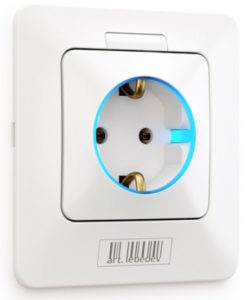
- With a built-in RCD (residual current device). It is used if for some reason such protection cannot be installed near the input machine, or there is a fear that it will not work.

- With individual counter. Such a device allows you to monitor in real time what power the device connected to the network develops. In addition to digital designations, there is an additional color indication that allows you to visually determine the degree of load on the socket contacts.
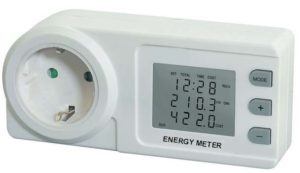
- With built-in timer. Allows you to turn off or turn on the device connected to the network at a specified time (or after a desired interval).

- Built-in USB output. Allows you not to occupy the outlet when charging the phone.
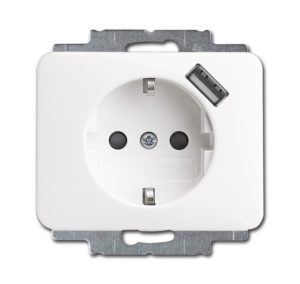
As a result
Regardless of how the outlet is arranged externally, its basic components are always the same. Due to this, when traveling to other countries, you can often use (or make yourself) an adapter to use the charging of a mobile phone or laptop. True, before that, you need to find out what standard is adopted in the country for the frequency and voltage of electric current.




